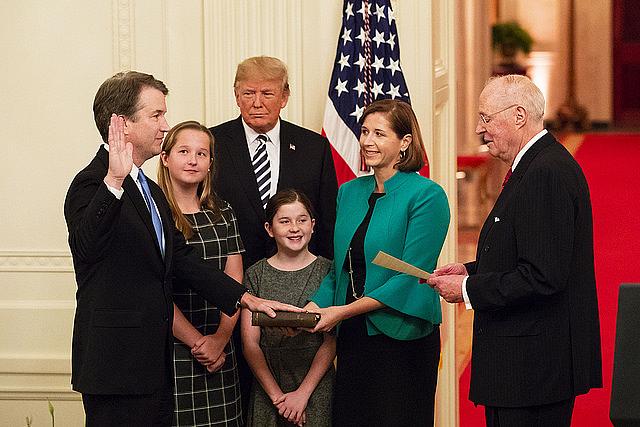What Kavanaugh's appointment to the court means for public health

Following a divisive national debate, Judge Brett Kavanaugh was sworn in Oct. 6 as the new associate justice on the U.S. Supreme Court.
I am often asked why public health should care about the role of the court and who sits on it. The answer is simple: Court rulings can support or overturn policies that dramatically affect the public’s health.
Public health uses policy creation and enforcement as essential tools to protect and promote health. Policy development means utilizing laws and regulations. Public health officials at the federal, state and local level have significant policymaking and enforcement authority. This means that our nation’s courts, especially the Supreme Court, which serves as the ultimate arbiter of legal disputes arising from acts of Congress, regulations of the federal agencies and case law from the federal judiciary has an enormous impact on the public’s health.
Kavanaugh replaces retired justice Anthony Kennedy, a moderate conservative who was often the swing vote on the court. Kavanaugh is decidedly more conservative than his predecessor and viewed by many to be more partisan in his approach to the law.
At his nomination in July, Kavanaugh stated that his “judicial philosophy is straightforward. A judge must be independent and must interpret the law and not make the law. A judge must interpret statutes as written. And a judge must interpret the Constitution as written, informed by history and precedent.”
His judicial record on health was recently reviewed by the American Public Health Association and what we found has the potential to shift the court in directions that could undermine core public health protections for decades.
Separation of powers
Kavanaugh supports a stronger presidency with little accountability until out of office. This would support measures that allow the chief executive to act without much accountability. In recent years presidents have used signing statements as well as executive orders to change health policy. Executive orders have the force of law within the confines of the executive branch. One such action was President Trump’s first executive order, which was designed to pave the way for repeal of the Affordable Care Act.
Administrative law
Kavanaugh supports less regulatory and administrative authority for the executive branch agencies. He has been a noted critic of the Chevron decision. Under the landmark 1984 Supreme Court case Chevron, U.S.A., Inc. v. NRDC, Inc., the court agreed that delegations of legislative authority are constitutional. This means that executive branch agencies have the authority to reasonably interpret statutory law when making the rules to implement said laws. Consider the fact that the Affordable Care Act gave enormous regulatory authority to executive branch agencies to further define and implement the law.
But Kavanaugh’s critical view of Chevron suggests he would support limiting the ability of agencies managing this law to implement or adjust the law’s many complicated and interrelated provisions without legislative action. In an environment in which Congress is as paralyzed as it is today, this could limit the ability to fine-tune the program.
His judicial record on the environment demonstrates his narrow view on the interpretation of the authority of the Environmental Protection Agency to address environmental pollution using the Clean Air Act, regulations essential to address climate change.
Public health
The issue of most concern to many is the impact Kavanaugh may have on reproductive rights. He has demonstrated in both his rulings and public statements that he supports limiting access to legal services like birth control and abortion. It is also unclear from his conflicting statements whether he considers Roe v. Wade, the 1973 Supreme Court decision that legalized abortion, settled law. This was a major flashpoint in his confirmation fight.
On other issues essential to protecting the public and improving public health, Kavanaugh has had a mixed record. He has supported food labeling and restrictions on e-cigarettes while opposing restrictions on firearms. In one vaccine case, Coalition for Mercury-free Drugs, Inc. v. Sebelius, he dismissed the case because the group’s members had never actually used vaccines with thimerosal, a preservative containing mercury used in some vaccines that some have feared may pose health risks. This case was not ruled on the safety of vaccines with thimerosal or any other merits of the case.
The future of the court
Now that Kavanaugh has joined the court, no one can precisely judge how the court will rule on any individual case. Most decisions are unanimous or decided with a clear majority. It is on the cutting-edge constitutional issues where the judicial views of an individual justice can swing public policy in dramatic ways. It is clear that the court will take a decidedly more conservative turn when these major questions will be answered with Kavanaugh’s addition to the court.
For issues that impact the public’s health, his opinions on the power of executive branch agencies probably will have the most overall impact and court watchers should carefully inspect what these mean for health. Even incremental measures that limit reproductive rights may set a judicial path to one day overturn Roe. Supporters of reproductive rights need to watch this very carefully. Finally, his views on the Second Amendment will be very impactful on a court that is inclined to make firearms more available.
Despite all the debate about what Kavanaugh’s addition to the court means, it is unclear what the ideological makeup of the court will be in the future. Overall the court’s members are young, with one justice in his 70s and two in their 80s. The likelihood of another vacancy or two is high within the next five years. The court can swing back to a more neutral balance, shift further to the right or with a more progressive president and Senate move more to the left. Only time will tell. One thing we can predict, the public’s health will be significantly impacted by the decisions of the court.
(Photo: The White House/Flickr)

